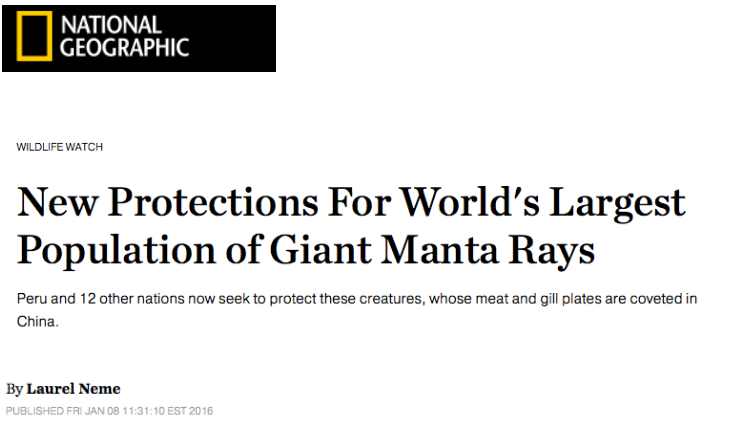National Geographic: New Protections For World’s Largest Population of Giant Manta Rays (2)

New Protections For World’s Largest Population of Giant Manta Rays
Peru and 12 other nations now seek to protect these creatures, whose meat and gill plates are coveted in China.
Giant manta rays captured the world’s attention last April when a fisherman in northern Peru unintentionally caught a behemoth weighing 2,000 pounds (900 kilograms).
The accidental snagging of this large ray (giant oceanic manta rays can weigh up to two tons) served to highlight global threats the rays face, and it spotlighted Peru, in whose waters many of the giants are found.
On December 31, 2015, Peru took a major step toward helping giant manta rays when it passed a resolution that not only bans manta fishing but also requires that fishermen immediately release any mantas caught accidentally as “bycatch” back into the ocean.
It’s not unusual for manta rays to get tangled in nets or fishing lines. But rays are also deliberately targeted for their meat and gills plates, which filter out plankton as they swim. The gill plates are considered a culinary delicacy in China, where they’re also used in traditional medicine to reduce toxins, enhance blood circulation, cure cancer, increase breast milk supply, and treat chickenpox and other ailments. There’s no scientific evidence that manta potions are effective in any of these instances.
According to WildAid, an NGO that aims to stop illegal trade in wildlife, the manta gill plate trade amounts to $30 million a year, 99 percent of it accounted for by one Chinese province: Guangzhou. Demand has soared in recent years, in part as an alternative to shark fin.
A recent New York Times report noted that overfishing has wrought havoc on many of the world’s manta populations. Little is known about overall numbers, but the International Union for Conservation of Nature’s Red List, which provides data on the population and conservation status of species, has found that certain regional populations have dropped by 80 percent during the past 75 years.
Manta rays reproduce extremely slowly, giving birth to one pup every two to five years, so even limited fishing has a significant impact. Peru is home to the world’s largest known population of giant manta rays.

A store clerk in China holds a manta ray gill. Gills are used in traditional medicine and are prized as a culinary delicacy, as is manta ray meat.Photograph by Paul Hilton, Barcroft Media/Getty Images
With its new regulations, Peru joins 12 other countries with varying degrees of manta ray protections. Peru’s mirror those in neighboring Ecuador, which is important for the regional population because the mantas migrate between the waters of the two countries.
The regulations don’t apply to mobula rays, a similar species also facing serious declines, but, says Peter Knights, WildAid’s executive director, “It’s a huge deal. With Indonesia, and now Peru, committing to protecting this species, two of the largest manta fisheries in the world are closed. We hope that other nations where mantas are threatened by local fisheries, particularly India and Sri Lanka, will follow suit.”
Laurel Neme is a freelance writer and author of Animal Investigators: How the World’s First Wildlife Forensics Lab is Solving Crimes and Saving Endangered Species. Follow her on Twitter and Facebook.

